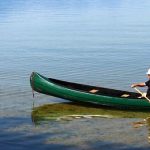The Square stern canoes have the appearance of a crossover between a rowing boat and a canoe.
The flattened rear of these types canoes are designed this way to be motor-ready, so you can cruise effortlessly across the water.
And this combined with great stability and load-bearing capabilities of square stern canoes, makes them very popular among anglers and duck hunters.
What are the Main Benefits of a Square Stern Canoe?
Motor Compatible
When you are geared up for a fishing or duck hunting trip, it may be difficult to move the canoe forward only using your own power. Canoes constructed with a square tail are crafted with the intention of having engines fitted to the back.
The motors can range from electric options that are lightweight and not very powerful to heavier and more potent gas outboards.
You can securely fit a trolling motor to a canoe with the correct motor mount. It is conceivable to fit out almost any canoe available as long as it is reliable enough with extra trolling motors that are mounted on the side.
If you intend to use a motor often, it is recommended that you purchase a canoe tailored to accommodate motor mounting.
Stability
Rectangular stern canoes are among the widest of the canoes that are available. Mounting a motor on the back can bring about more drag, however it will not be perceptible.
The increased width prevents you from overturning and your engine being submerged, and also enables you to navigate and make sharp turns without appearing unsteady.
The stability of these canoes is especially valued by duck hunters and anglers.
Fishermen desire the ability to stand while they are fishing in order to have more control over their environment, while those that go duck hunting need to be certain that the kickback from their shots won’t cause them to fall off the boat.
Capacity
The expansive size of square stern canoes allows them to hold more weight than most other types of canoes. This is excellent for fishermen or hunters that require a lot of gear for their outings and those that return with greater catches than they take out.
These canoes are well-suited and steady enough for bigger adults.
It’s essential to keep in mind that when you’re operating a square stern canoe, the total weight includes you, your gear, and the motor. Don’t exceed 70% of the stated capacity in order to keep your canoe performing optimally.
Your canoe should not be loaded with more than 280 lbs if it has a capacity of 400 lbs.
Where can you paddle a Square Stern Canoe?
Square stern canoes are usually best for smooth, leisurely bodies of water. It’s likely that you are using boats for fishing or duck hunting, which means you won’t be on rough rivers or against powerful waves.
Using a motor can make a big difference in how much distance you can cover in a day on a large lake. If you’re relying on just a paddle, you’ll likely have a hard time covering a lot of ground.
Drawbacks of a Square Stern Canoe
Lack of Tracking
When you cut the pointed end of a canoe, you decrease the boat’s ability to travel straight. The squared area has been given a thicker bottom part to keep it stable.
This results in the removal of a part of the keel line that would act as a rudder-like feature on the canoe.
The style of Square stern canoes may differ, but usually they possess a good amount of hull curvature at the bow. This bow arrangement enables the canoe to glide across the water, especially when it is powered by an engine, and lets it go over any minor bumps or ripples.
Without the canoe’s keel, it would sink into the lake and may cause you to lose control and possibly overturn.
Taking both hull modifications into account, the canoe’s waterline is affected. The area usually used for steering has a limited amount of traction due to the sharp v-shaped hull design, thus making it difficult to control the movements.
Navigating these canoes into or against the wind without a motor can be very hard even on calm days.
Wide and hard to Paddle
Wider canoes are slower across the water. The increased air resistance from the broad, flat hull restricts the highest rate of speed. These canoes, which lack the ability to be tracked, aren’t meant to travel far without help from a motor.
Canoes with an extra wide design are able to make sharp turns more easily than their more narrow versions, which tend to float in circles that are wider.
However, these broad canoes are not meant to be paddled skillfully. You can utilize these in tandem, but navigations with tight circles and cautious and controlled maneuvers won’t have the same outcome as they would on your additional leisure canoes.
Heavy
These canoes are constructed to be sturdy enough to transport supplies and come equipped with additional supporting structure at the stern to mount an engine. They are also wide and stable.
All the additional components that make up a square stern canoe come with a weight penalty, making these boats some of the heaviest available.
It’s unlikely that you’ll be able to transport these canoes by yourself, as they can frequently weigh over 100 lbs.
A canoe trolley is necessary in order to move your square stern canoe along with all the equipment from the parking lot to the shoreline, especially if you’d like to do it all in one journey.
Who should use a Square Stern Canoe?
The principal justification for having a square stern canoe is the capability to attach a motor. Certainly there are advantages to these canoes apart from what is stated.
You can find them in alternate forms that do not display some of the issues associated with a square stern canoe. It is unlikely that a square stern canoe would be employed if no motor is being utilized.
Because of this, the majority of canoes are mainly utilized by fishermen and hunters who take advantage of their steadiness and the more room they provide. People of all ages and sizes will find advantages from the stability of the canoe.
However there are other canoes available that afford a lot of space as well as excellent equilibrium. If you plan to attach a motor to your canoe, a square stern canoe is the ideal option.
Aluminum Canoes
Canoes have long been typically constructed out of aluminum. At the conclusion of World War II, companies that make combat aircraft started to use the same technique of expanding aluminum to construct canoes.
Aluminum is too pliable to be used solely to construct a canoe, thus a combination of other metals and aluminum is necessary in order to achieve a robust material.
Aluminum canoes are frequently preferred for family excursions or other recreational canoeing activities. These boats are very hard-wearing and require little upkeep, a feature which makes them a great choice for amateur canoeists who are honing their abilities.
Pros of Aluminum Canoes
Although there have been developments in the materials used to make canoes, aluminium is still a preferred selection for many people because of its advantages.
This aluminum canoe has definitely been given its title of the “Boy Scout or family boat” for good reason.
Some of the benefits of aluminum canoes include:
- Durability – Aluminum canoes are strong and hold up for a long time. Because the aluminum is so durable, they can be left out in the elements for long periods without much damage. Extreme temperatures rarely have any effect on aluminum canoes.
- Low Maintenance – Aluminum canoes don’t need much maintenance to ensure their durability. These canoes can survive a lot of bumps without needing repairs because most impacts will only leave a dent. Such dents typically don’t affect the canoe’s performance.
- Inexpensive – If you’re looking for an inexpensive canoe, you’ll likely find that aluminum choices are relatively economical. Since aluminum canoes were produced in massive numbers in the 20 th century, used ones aren’t too expensive.
This especially became true after the 1970s because canoes became accessible to middle class families looking for recreation. Careful though, as paddling popularity increases, quality aluminum canoe prices have actually risen in recent years.
Flatwater trips, family paddling jaunts, or rookie adventurers are all ideal setups for aluminum canoes.
Cons of Aluminum Canoes
Advantages of aluminum canoes are plentiful, however, there are some disadvantages to consider when selecting this type of canoe. The disadvantages are more noticeable since newer materials are now utilized in the construction of canoes.
Aluminum canoes do have some flaws, including:
- Weight – Aluminum canoes can be quite heavy. They typically still weigh less than a wooden canoe, but aluminum canoes are not the easiest to portage (moving a canoe across dry land).
- Design Issues – Because aluminum canoes consist of two metal pieces welded or riveted together, they’re not usually the most attractive. Aluminum canoes also catch on rocks easily; severe hull damage doesn’t usually occur, but it is a hassle to repeatedly get stuck on rocks.
- Material – Aluminum canoes are often very noisy, which can be a nuisance when you want to have a relaxing time on the water. The aluminum also absorbs heat, so the canoe’s surface can get too hot to touch comfortably in heat of summer.
Many individuals still opt for aluminum canoes, despite the disadvantages, because they recognize that it will grant them a sturdy vessel for a prolonged period of time.
Lightweight Canoes
Recently developed technology has enabled producers to offer a greater selection of canoe styles. The demand for canoes increased greatly as newer materials were introduced, making them much easier to transport and maneuver.
Canoes that are not heavy are typically employed for competitions or treks that necessitate a substantial amount of moving by hand. For flatwater voyages, many individuals favor lightweight canoes because they rapidly move through the liquid.
Some canoes, depending on the materials and their weight, can be suitable for use on whitewater trips.
Most lightweight canoes are generally made up of composite components such as fabric cloth and resin, like epoxy, fused together in layers.
Kevlar Canoes
Kevlar is commonly employed in the construction of canoes. This material is frequently employed in bulletproof vests, but it is also highly sought after for canoe manufacturing.
Kevlar is typically not strong enough to withstand an impact on its own, so it is usually combined with other materials to give it additional strength.
It is essential to be aware that the heaviness of a Kevlar canoe is linked to the robustness of the canoe. A canoe’s weight will determine its strength; the less heavy it is, the lower its capacity for endurance.
This is advantageous if you are paddling in water with frequent carry-overs, yet it can be damaging when the flow rate is high and the riverbed is full of rocks.
Pros of Kevlar Canoes
If you’re searching for a quality ultralight canoe, Kevlar models may provide you with everything you are looking for.
Kevlar canoes have many benefits, including:
- Extremely Lightweight – Kevlar canoes are some of the lightest options on the market. They are easy to portage, which makes them a great choice for trips that involve a lot of movement across land.
- Design Options – Because Kevlar canoes are built in layers over a mold, there are nearly endless options for design. Kevlar canoes are often built with performance in mind, so they will be shaped in a way that maximizes their in-water performance.
- Speed – Since Kevlar canoes are so light, they can be paddled fast. Even with the speed though, these canoes are still easy to maneuver, which is key for a lot of people.
It’s not hard to figure out why Kevlar canoes are a favored selection if your goal is to get a speedy, light boat.
Cons of Kevlar Canoes
No matter what type of canoe, each one has its own pros and cons, and the same is true of canoes made of Kevlar. Many aspects that make Kevlar canoes desirable for some people are actually seen as adverse for others.
Kevlar canoes are not always preferable because:
- Higher Cost – The materials used in constructing Kevlar canoes are more expensive than traditional materials like wood or aluminum. While Kevlar canoes are starting to come in a wider variety of prices, they still are some of the most expensive canoes.
- Durability – Kevlar canoes are not always consistently durable. The lighter the canoe is, the more prone to damage it is. Thus, Kevlar canoes have limits to what kinds of waters can be handled easily or safely.
- Maintenance – Because Kevlar canoes are not as durable, they can require more maintenance. Generally, these canoes need protection from UV exposure when they are not in use. Repairs are also costly to make.
Carbon Fiber Canoes
Another material that is often utilized for the creation of light weight canoes is carbon fiber. Carbon fiber canoes are just as featherweight as Kevlar canoes.
Mixtures of carbon fiber and other components are frequently utilized to provide the ideal amount of suppleness.
These canoes are frequently utilized for competition due to their solid structure, which facilitates speedy velocities.
A carbon fiber canoe can be made by combining a liquid resin with the material over a mould, then using a vacuuming process to remove any surplus resin. A gel coat then finishes the surface.




